Abstract
The pharmacodynamics of dosage regimens of piperacillin alone or in combination with tazobactam against piperacillin-resistant or -susceptible bacteria were studied in an in vitro model of infection. Experiments were conducted by using a fixed daily exposure of 12 g of piperacillin, given as 3 g alone or in combination with tazobactam at 0.375 g every 6 h, or the same total dose of the combination given as 4 g of piperacillin plus 0.5 g of tazobactam every 8 h. The addition of tazobactam to piperacillin, irrespective of the dosing interval, did not alter the killing of piperacillin-susceptible organisms (Escherichia coli J53 and Pseudomonas aeruginosa ATCC 27853). In contrast, experiments with an isogenic TEM-3-containing transconjugant of E. coli J53 (E. coli J53.2-TEM-3) that was resistant to piperacillin (MIC, 128 micrograms/ml) showed that the addition of tazobactam resulted in bacterial killing similar to that observed with the wild-type strain. Although tazobactam concentrations fell to less than 4 mg/liter (the concentration associated with a reduction in the piperacillin MIC from 128 to 2 mg/liter) 2 to 3 h after a dose, a similar degree of bacterial killing was observed when the same total 24-h dose of piperacillin-tazobactam was fractionated into dosing intervals of every 6 or 8 h. Investigations with Staphylococcus aureus 7176 (piperacillin MIC, 128 micrograms/ml) showed that the addition of tazobactam, again irrespective of dosing interval, also resulted in net bacterial killing which was not seen with piperacillin alone. These data support the use of extended dosing intervals (every 8 h) of piperacillin-tazobactam in the treatment of infections caused by piperacillin-resistant bacteria.
Full text
PDF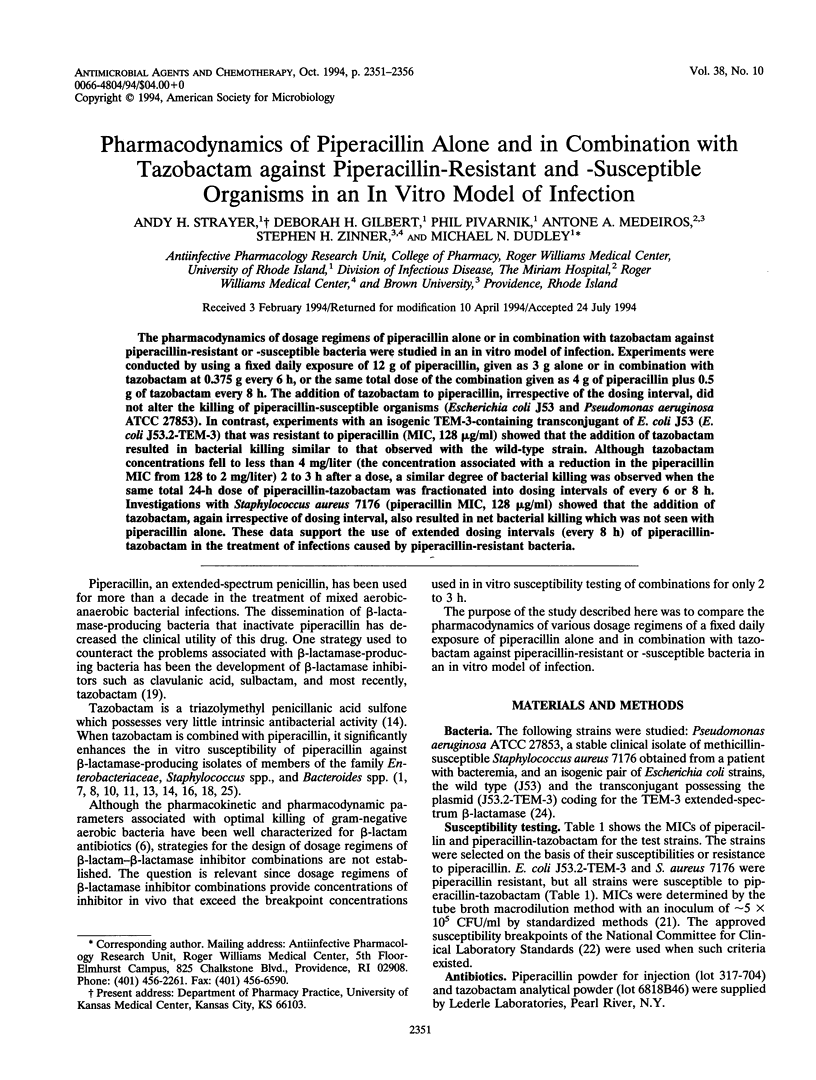
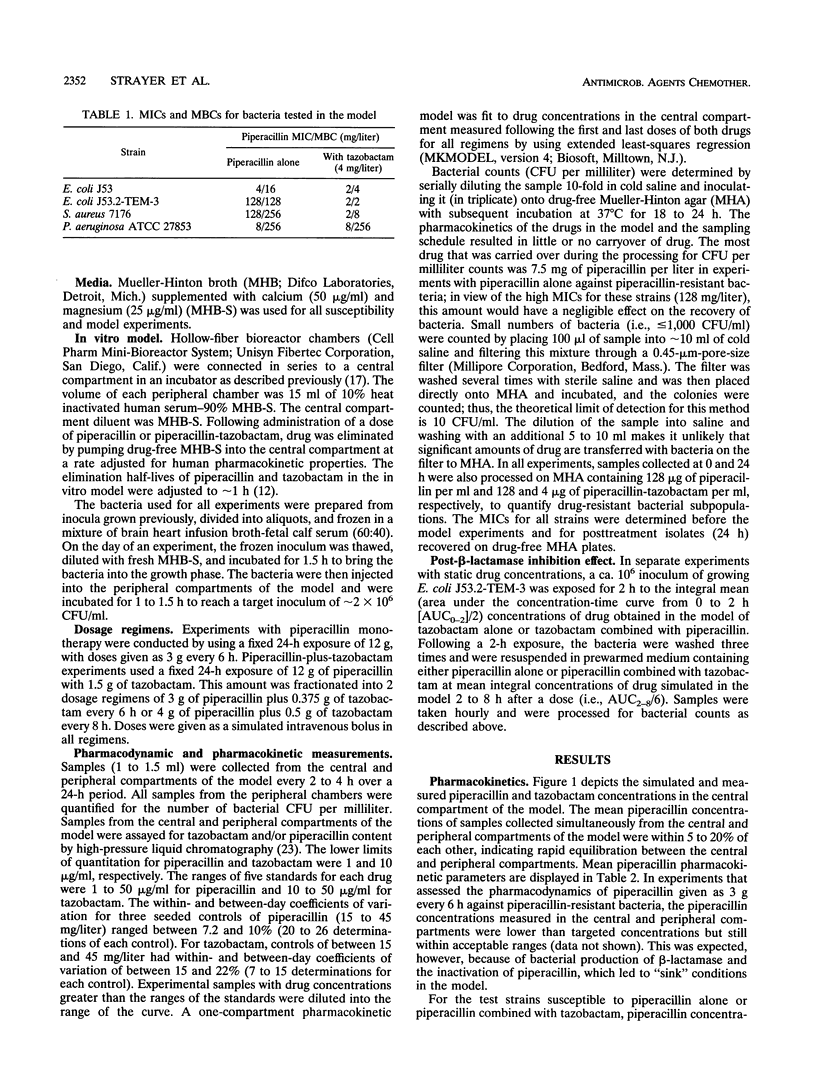
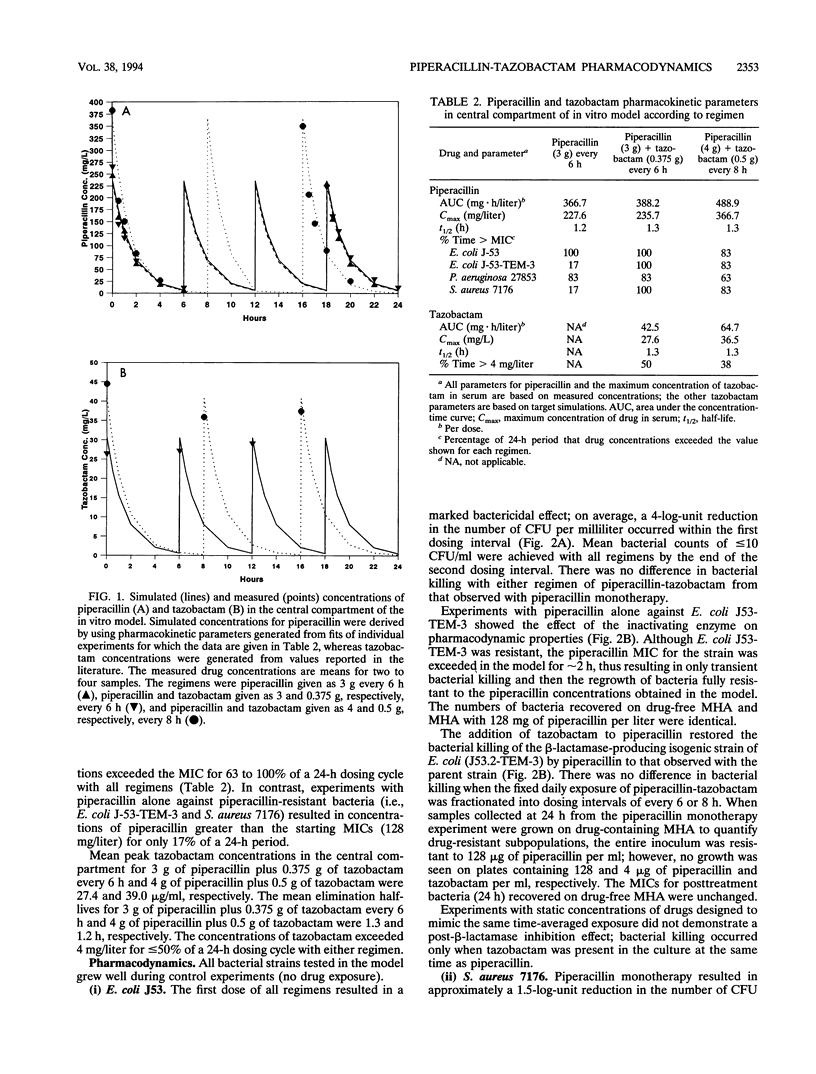
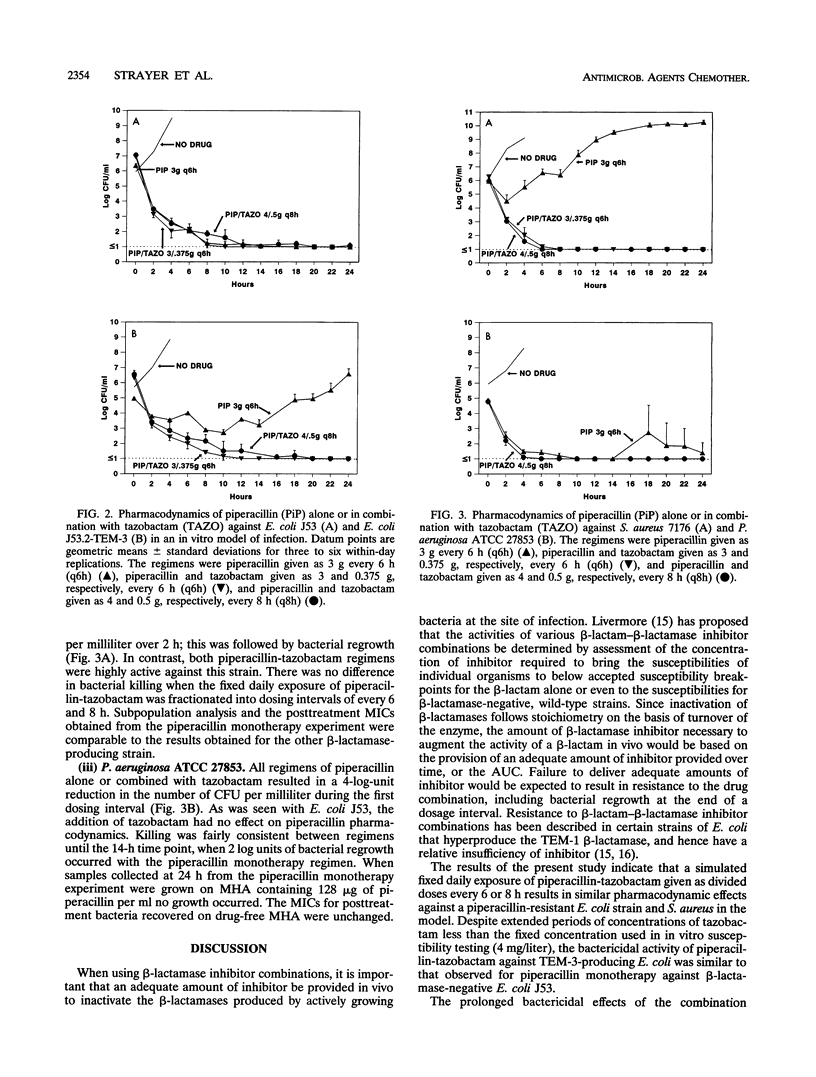
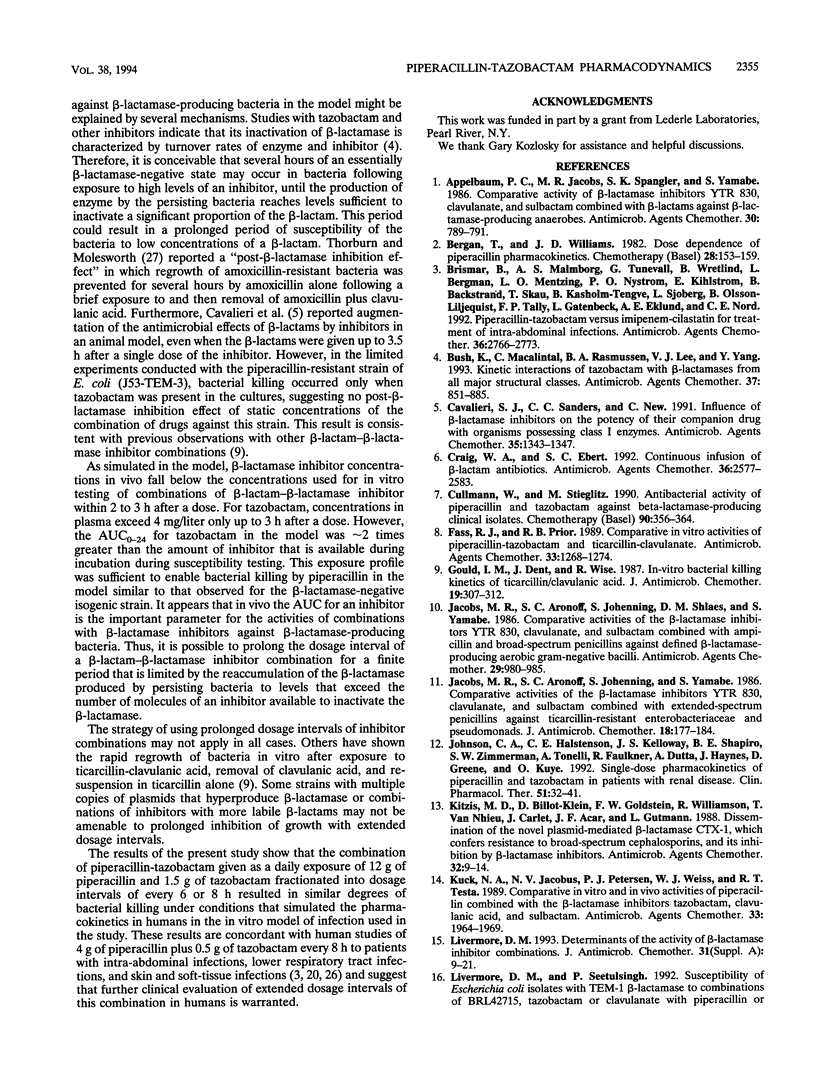
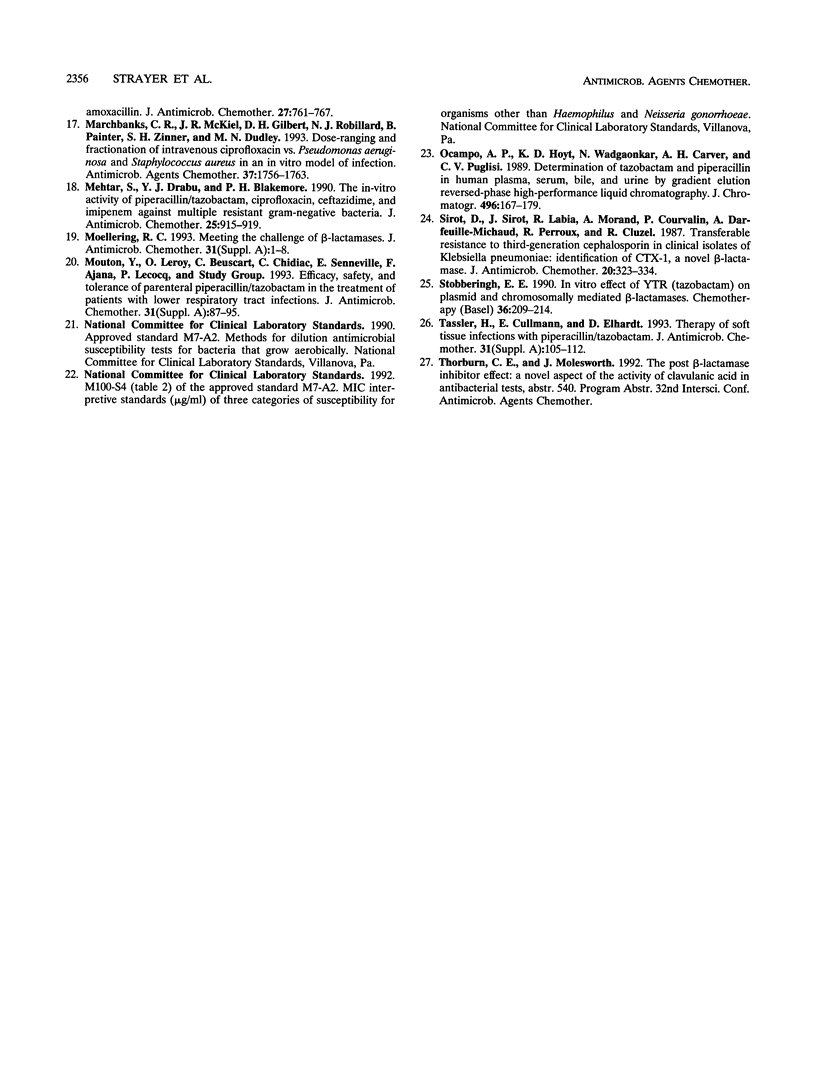
Selected References
These references are in PubMed. This may not be the complete list of references from this article.
- Appelbaum P. C., Jacobs M. R., Spangler S. K., Yamabe S. Comparative activity of beta-lactamase inhibitors YTR 830, clavulanate, and sulbactam combined with beta-lactams against beta-lactamase-producing anaerobes. Antimicrob Agents Chemother. 1986 Nov;30(5):789–791. doi: 10.1128/aac.30.5.789. [DOI] [PMC free article] [PubMed] [Google Scholar]
- Bergan T., Williams J. D. Dose dependence of piperacillin pharmacokinetics. Chemotherapy. 1982;28(3):153–159. doi: 10.1159/000238070. [DOI] [PubMed] [Google Scholar]
- Brismar B., Malmborg A. S., Tunevall G., Wretlind B., Bergman L., Mentzing L. O., Nyström P. O., Kihlström E., Bäckstrand B., Skau T. Piperacillin-tazobactam versus imipenem-cilastatin for treatment of intra-abdominal infections. Antimicrob Agents Chemother. 1992 Dec;36(12):2766–2773. doi: 10.1128/aac.36.12.2766. [DOI] [PMC free article] [PubMed] [Google Scholar]
- Bush K., Macalintal C., Rasmussen B. A., Lee V. J., Yang Y. Kinetic interactions of tazobactam with beta-lactamases from all major structural classes. Antimicrob Agents Chemother. 1993 Apr;37(4):851–858. doi: 10.1128/aac.37.4.851. [DOI] [PMC free article] [PubMed] [Google Scholar]
- Cavalieri S. J., Sanders C. C., New C. Influence of beta-lactamase inhibitors on the potency of their companion drug with organisms possessing class I enzymes. Antimicrob Agents Chemother. 1991 Jul;35(7):1343–1347. doi: 10.1128/aac.35.7.1343. [DOI] [PMC free article] [PubMed] [Google Scholar]
- Craig W. A., Ebert S. C. Continuous infusion of beta-lactam antibiotics. Antimicrob Agents Chemother. 1992 Dec;36(12):2577–2583. doi: 10.1128/aac.36.12.2577. [DOI] [PMC free article] [PubMed] [Google Scholar]
- Cullmann W., Stieglitz M. Antibacterial activity of piperacillin and tazobactam against beta-lactamase-producing clinical isolates. Chemotherapy. 1990;36(5):356–364. doi: 10.1159/000238788. [DOI] [PubMed] [Google Scholar]
- Fass R. J., Prior R. B. Comparative in vitro activities of piperacillin-tazobactam and ticarcillin-clavulanate. Antimicrob Agents Chemother. 1989 Aug;33(8):1268–1274. doi: 10.1128/aac.33.8.1268. [DOI] [PMC free article] [PubMed] [Google Scholar]
- Gould I. M., Dent J., Wise R. In-vitro bacterial killing kinetics of ticarcillin/clavulanic acid. J Antimicrob Chemother. 1987 Mar;19(3):307–312. doi: 10.1093/jac/19.3.307. [DOI] [PubMed] [Google Scholar]
- Jacobs M. R., Aronoff S. C., Johenning S., Shlaes D. M., Yamabe S. Comparative activities of the beta-lactamase inhibitors YTR 830, clavulanate, and sulbactam combined with ampicillin and broad-spectrum penicillins against defined beta-lactamase-producing aerobic gram-negative bacilli. Antimicrob Agents Chemother. 1986 Jun;29(6):980–985. doi: 10.1128/aac.29.6.980. [DOI] [PMC free article] [PubMed] [Google Scholar]
- Jacobs M. R., Aronoff S. C., Johenning S., Yamabe S. Comparative activities of the beta-lactamase inhibitors YTR 830, clavulanate and sulbactam combined with extended-spectrum penicillins against ticarcillin-resistant Enterobacteriaceae and pseudomonads. J Antimicrob Chemother. 1986 Aug;18(2):177–184. doi: 10.1093/jac/18.2.177. [DOI] [PubMed] [Google Scholar]
- Johnson C. A., Halstenson C. E., Kelloway J. S., Shapiro B. E., Zimmerman S. W., Tonelli A., Faulkner R., Dutta A., Haynes J., Greene D. S. Single-dose pharmacokinetics of piperacillin and tazobactam in patients with renal disease. Clin Pharmacol Ther. 1992 Jan;51(1):32–41. doi: 10.1038/clpt.1992.5. [DOI] [PubMed] [Google Scholar]
- Kitzis M. D., Billot-Klein D., Goldstein F. W., Williamson R., Tran Van Nhieu G., Carlet J., Acar J. F., Gutmann L. Dissemination of the novel plasmid-mediated beta-lactamase CTX-1, which confers resistance to broad-spectrum cephalosporins, and its inhibition by beta-lactamase inhibitors. Antimicrob Agents Chemother. 1988 Jan;32(1):9–14. doi: 10.1128/aac.32.1.9. [DOI] [PMC free article] [PubMed] [Google Scholar]
- Kuck N. A., Jacobus N. V., Petersen P. J., Weiss W. J., Testa R. T. Comparative in vitro and in vivo activities of piperacillin combined with the beta-lactamase inhibitors tazobactam, clavulanic acid, and sulbactam. Antimicrob Agents Chemother. 1989 Nov;33(11):1964–1969. doi: 10.1128/aac.33.11.1964. [DOI] [PMC free article] [PubMed] [Google Scholar]
- Livermore D. M. Determinants of the activity of beta-lactamase inhibitor combinations. J Antimicrob Chemother. 1993 Jan;31 (Suppl A):9–21. doi: 10.1093/jac/31.suppl_a.9. [DOI] [PubMed] [Google Scholar]
- Marchbanks C. R., McKiel J. R., Gilbert D. H., Robillard N. J., Painter B., Zinner S. H., Dudley M. N. Dose ranging and fractionation of intravenous ciprofloxacin against Pseudomonas aeruginosa and Staphylococcus aureus in an in vitro model of infection. Antimicrob Agents Chemother. 1993 Sep;37(9):1756–1763. doi: 10.1128/aac.37.9.1756. [DOI] [PMC free article] [PubMed] [Google Scholar]
- Mehtar S., Drabu Y. J., Blakemore P. H. The in-vitro activity of piperacillin/tazobactam, ciprofloxacin, ceftazidime and imipenem against multiple resistant gram-negative bacteria. J Antimicrob Chemother. 1990 Jun;25(6):915–919. doi: 10.1093/jac/25.6.915. [DOI] [PubMed] [Google Scholar]
- Moellering R. C., Jr Meeting the challenges of beta-lactamases. J Antimicrob Chemother. 1993 Jan;31 (Suppl A):1–8. doi: 10.1093/jac/31.suppl_a.1. [DOI] [PubMed] [Google Scholar]
- Mouton Y., Leroy O., Beuscart C., Chidiac C., Senneville E., Ajana F., Lecocq P. Efficacy, safety and tolerance of parenteral piperacillin/tazobactam in the treatment of patients with lower respiratory tract infections. J Antimicrob Chemother. 1993 Jan;31 (Suppl A):87–95. doi: 10.1093/jac/31.suppl_a.87. [DOI] [PubMed] [Google Scholar]
- Ocampo A. P., Hoyt K. D., Wadgaonkar N., Carver A. H., Puglisi C. V. Determination of tazobactam and piperacillin in human plasma, serum, bile and urine by gradient elution reversed-phase high-performance liquid chromatography. J Chromatogr. 1989 Nov 10;496(1):167–179. doi: 10.1016/s0378-4347(00)82563-3. [DOI] [PubMed] [Google Scholar]
- Sirot D., Sirot J., Labia R., Morand A., Courvalin P., Darfeuille-Michaud A., Perroux R., Cluzel R. Transferable resistance to third-generation cephalosporins in clinical isolates of Klebsiella pneumoniae: identification of CTX-1, a novel beta-lactamase. J Antimicrob Chemother. 1987 Sep;20(3):323–334. doi: 10.1093/jac/20.3.323. [DOI] [PubMed] [Google Scholar]
- Stobberingh E. E. In vitro effect of YTR (tazobactam) on plasmid and chromosomally mediated beta-lactamases. Chemotherapy. 1990;36(3):209–214. doi: 10.1159/000238768. [DOI] [PubMed] [Google Scholar]
- Tassler H., Cullmann W., Elhardt D. Therapy of soft tissue infections with piperacillin/tazobactam. J Antimicrob Chemother. 1993 Jan;31 (Suppl A):105–112. doi: 10.1093/jac/31.suppl_a.105. [DOI] [PubMed] [Google Scholar]


